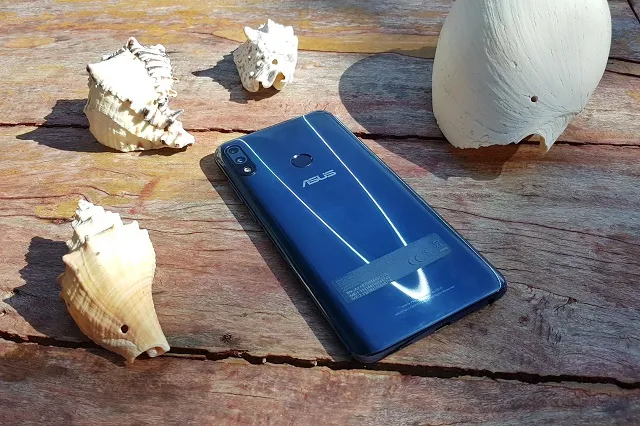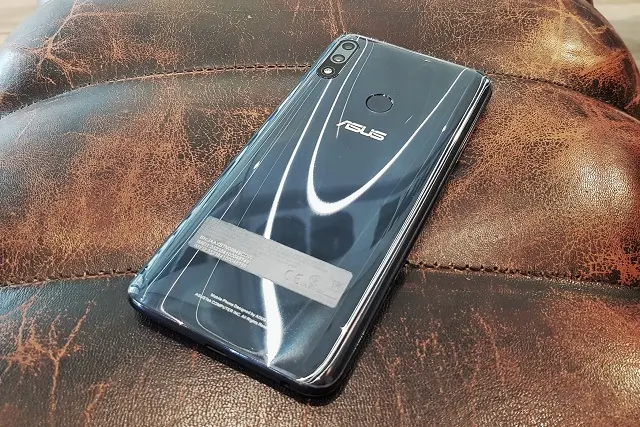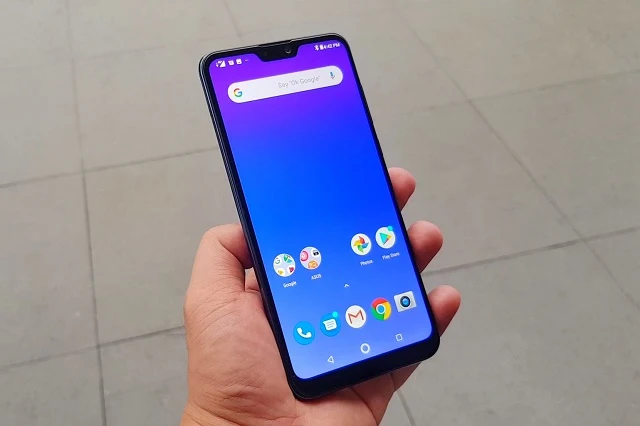ASUS Zenfone Max Pro M2 continues to gather users in the budget-friendly segment as it delivers performance over price. Straight from the heels of success of the Zenfone Max Pro M1, gaming and battery-oriented fans have been very excited of this release. With a better chipset, Snapdragon 660, and more features in its sleeve, the Zenfone Max Pro M2 is an exciting handset in an enticing starting price of PHP 12,995. If you’re toying for a smartphone purchase early this year, you might want to read this review and have a second look at the new Zenfone Max Pro M2.


The Design
The ASUS Zenfone Max Pro M2 sports a 3D glossy back which visually gives off a glass finish. But make not mistake, the back is entirely polycarbonate plastic which gives off stunning reflective patterns when struck by light. It is very appealing but once you get a hold of it, you’ll know pretty sure that it's a fingerprint magnet and slippery on the hands.
The handset packs a 5000 mAh battery but it is surprisingly on the lighter side. Likewise, I couldn’t help but notice the creaking sound once you try to press the back panel. It gave me an impression that the chassis is not thick enough to endure pinching pressures. It picks up scratches quite easily; and it’s also a bad idea that the box does not include a case.
Update: (We found out that the retail units come with a case and headphones, so that's great!)
Update: (We found out that the retail units come with a case and headphones, so that's great!)
Moving on, you can find the ASUS logo on the upper middle portion of the back panel below the fingerprint sensor. The vertically-aligned dual camera module is in its no-nonsense position together with the LED flash. At the bottom, you’ll see the micro-USB port, the 3.5-mm audio jack, the microphone and two horizontal speaker slits.
The left side houses the SIM tray which accommodates two SIM cards and a microSD card at the same time; while the right side is a home to the power button and the volume rocker. Overall, the design is pretty good. Given the aggressive pricing, ASUS justifies the cuts in the design for some big features that we will discuss in the next segments.
The Display
The ASUS Zenfone Max Pro M2 frames with a 6.3-inch display; and just like most of its competitors, it comes with a notch that houses the front-facing camera and other essential sensors. ASUS is also generous enough to include a Gorilla Glass 6 treatment on the display. It is one of the firsts in the Philippine market to use this latest glass protection from Corning.
Bezels are also slimmer on the top and sides, while the bottom bezel is relatively thicker. In order to have smaller notch, ASUS pushed the earpiece towards the edge of the frame – a design which we have seen with OPPO and Vivo smartphones.
The display is vibrant and color reproduction is quite accurate. I could also say that this FHD+ panel is brighter than most LCD panels I’ve used. It comes with 450 nits which could be very legible even under direct sunlight. You can also adjust the color temperature slider in the Settings app. Viewing angles are also generous even when you are in oblique angles.
Performance: Multimedia, Gaming, Sound Quality
The ASUS Zenfone Max Pro M2 is definitely a good multimedia device. Its wide display makes it hard to put down once you started watching videos or streaming in your favorite apps. Running tasks with the handset is quite snappy, thanks to the powerful processor, 6GB of RAM, and stock Android experience.
In gaming, the Zenfone Max Pro M2 comes to play. It’s definitely a gaming machine that could run wide range of gaming apps, even the graphic intensive ones. It’s one of my favorite smartphones for Ragnarok Mobile and Subway Surfers. It’s also a good device for PUBG Mobile with Balanced Graphics and Medium frame rate. You can feel a slight processor warming due extensive gaming, but you don’t have to worry about that.
The handset also boasts a great audio quality. It shoots crisp sound and defined bass due to the NXP 9874 smart amplifier.
We have difficulties in running Antutu Benchmark. The 3D benchmarking app says it's not compatible with the phone. But our GeekBench test gave the handset a single-core score of 719 and a multiple-core score of 2250.
We have difficulties in running Antutu Benchmark. The 3D benchmarking app says it's not compatible with the phone. But our GeekBench test gave the handset a single-core score of 719 and a multiple-core score of 2250.
Camera
Photo quality on the Zenfone Max Pro M2 is way better than what we had with Zenfone Max Pro M1. This is the area where ASUS has improved the most. In good lighting conditions, Zenfone Max Pro M2 shoots great images with on point color reproduction, impressive details, and contrast. However, it still struggles in low-light conditions but shots came with big improvements compared to the model it replaces.
It’s now more accurate in terms of AI. The interface quickly blends the right optimization setting for the right scene. In terms of selfie, the ASUS Zenfone Max Pro M2 is also a winner. I still love its beautification suite; and it now comes with Low, Mid, and High presets. You can even opt to use custom sliders for softening or whitening your skin tones.
There’s a lot of improvements with the camera but it’s still a hit-and-miss case when it comes to photo quality. One thing I’ve noticed is the fact that the camera app’s viewfinder displays a different tone compared to what you will see in the actual photo.
Marcos are now better in separating subjects from the background. The portrait mode is very accessible in the camera app interface; while its outputs gave a better edge detection.
Check sample photos below.
More sample shots here: https://photos.app.goo.gl/BDYdDogwAZxkMxq59
The ASUS Zenfone Max Pro M2 could record 4K videos in 30fps which is quite amazing for a mid-range handset. We have tested its video recording capability in 1080p. The video stabilization is only limited in 1080p. But it gets the job done once it kicks in. Check out the sample video below.
Software
It’s also a breath of fresh air to see a stock Android software on an ASUS smartphone. The ASUS Zenfone Max Pro M2 boots with Android Oreo 8.1. I was expecting this to get Android Pie on the get-go but I’m sure ASUS is readying an update early this year.
The interface is fast and clean. The purist in me is screaming with joy while navigating thru the handset’s UI.
It’s quick to respond to touches and familiar Android features can be seen everywhere like the Notification Shade, Google Assistant, etc.
Fingerprint sensor is fast enough to unlock your phone though it may not be as fast as its closest competitors. You can also opt to use the facial unlock for added convenience.
Battery
The ASUS Zenfone Max Pro M2 comes with a juicy 5,000 mAh battery. We ran an HD movie in our battery loop test and the handset did a 16-hour and 51-minute playback.
In our average daily usage, we tried listening to an hour of music streaming via WiFi, 30-minute Ragnarok Mobile gaming, an hour of Netflix streaming via WiFi, three dozen of photos captured using the camera, 30 minutes of chatting over varied messaging apps, occasional emails and web browsing. Our day ended with 43 percent in the bank.
Charging the phone using the out-of-the-box cable and adapter allows me to charge from zero to 50 percent within an hour. This is quite a feat for a smartphone under a Zenfone Max line.
Marcos are now better in separating subjects from the background. The portrait mode is very accessible in the camera app interface; while its outputs gave a better edge detection.
Check sample photos below.
More sample shots here: https://photos.app.goo.gl/BDYdDogwAZxkMxq59
The ASUS Zenfone Max Pro M2 could record 4K videos in 30fps which is quite amazing for a mid-range handset. We have tested its video recording capability in 1080p. The video stabilization is only limited in 1080p. But it gets the job done once it kicks in. Check out the sample video below.
Software
It’s also a breath of fresh air to see a stock Android software on an ASUS smartphone. The ASUS Zenfone Max Pro M2 boots with Android Oreo 8.1. I was expecting this to get Android Pie on the get-go but I’m sure ASUS is readying an update early this year.
It’s quick to respond to touches and familiar Android features can be seen everywhere like the Notification Shade, Google Assistant, etc.
Fingerprint sensor is fast enough to unlock your phone though it may not be as fast as its closest competitors. You can also opt to use the facial unlock for added convenience.
Battery
The ASUS Zenfone Max Pro M2 comes with a juicy 5,000 mAh battery. We ran an HD movie in our battery loop test and the handset did a 16-hour and 51-minute playback.
In our average daily usage, we tried listening to an hour of music streaming via WiFi, 30-minute Ragnarok Mobile gaming, an hour of Netflix streaming via WiFi, three dozen of photos captured using the camera, 30 minutes of chatting over varied messaging apps, occasional emails and web browsing. Our day ended with 43 percent in the bank.
Charging the phone using the out-of-the-box cable and adapter allows me to charge from zero to 50 percent within an hour. This is quite a feat for a smartphone under a Zenfone Max line.
The Wrap
This smartphone is living the Zenfone Max Series legacy. For its price, the ASUS Zenfone Max Pro M2 ticks many boxes - premium looking design, super bright display, dependable battery, and hard-working processor. ASUS also made a very good decision sticking with stock Android experience. With the advent of more powerful smartphones in this category, ASUS has the competitive edge.
The ASUS Max Pro M2 might come average in terms of the camera, but it instantly overcomes it with multiple amazing features in a very competitive price. 2019 is the time where mid-range phones become consistent in giving performance and value-for-money; and this smartphone definitely sticks out from the bunch.
Highlights:
1. Stock Android Experience
2. Long Battery Life
3. Very Vibrant Display
4. Premium flashy design
5. Fast and Efficient chipset
6. Considerably thin for a 5000-mAh phone
7. Great multimedia device
Lowlights:
1. Inconsistent and average camera
2. Smudge and Fingerprint Magnet
This smartphone is living the Zenfone Max Series legacy. For its price, the ASUS Zenfone Max Pro M2 ticks many boxes - premium looking design, super bright display, dependable battery, and hard-working processor. ASUS also made a very good decision sticking with stock Android experience. With the advent of more powerful smartphones in this category, ASUS has the competitive edge.
The ASUS Max Pro M2 might come average in terms of the camera, but it instantly overcomes it with multiple amazing features in a very competitive price. 2019 is the time where mid-range phones become consistent in giving performance and value-for-money; and this smartphone definitely sticks out from the bunch.
Highlights:
1. Stock Android Experience
2. Long Battery Life
3. Very Vibrant Display
4. Premium flashy design
5. Fast and Efficient chipset
6. Considerably thin for a 5000-mAh phone
7. Great multimedia device
Lowlights:
1. Inconsistent and average camera
2. Smudge and Fingerprint Magnet
ASUS Zenfone Max Pro M2 (ZB631KL) Specs
6.3-inch FHD+ (1080 x 2280p resolution) All-Screen Display
19:9 Aspect Ratio, 88% Screen-to-Body Ratio
Corning Gorilla Glass 6 (AI Engine)
Qualcomm Snapdragon 660 SoC
Octa-core Kryo 260 processor
Adreno 512
4GB/6GB RAM
64GB Storage
Rear: Dual Camera, 12MP Sony IMX486 (f/1.8, AI Scene Detection) + 5MP (Depth Sensing), up to 1080p 30 fps video recording
Front:13MP wide-angle camera (77.2-degree, f/2.0 aperture)
Front and Rear Softlight LED Flash
4G LTE
Wi-Fi 802.11 a/b/g/n
Bluetooth 5.0
GPS/A-GPS, GLONASS
Micro USB 2.0
3.5-mm Headphone Jack
NXP 9874 Smart Amplifier, 5-Magnet Speaker
Triple Slots (Dual LTE SIM Slot, microSD slot)
Fingerprint Sensor (rear mounted)
157.9x75.5x8.5mm at grams
5000 mAh battery
Android 8.0 Oreo with Planned Upgrade to Android 9.0 Pie
Midnight Blue, Cosmic Titanium
PHP 14,995 (6GB RAM)
PHP 12,995 (4GB RAM)
6.3-inch FHD+ (1080 x 2280p resolution) All-Screen Display
19:9 Aspect Ratio, 88% Screen-to-Body Ratio
Corning Gorilla Glass 6 (AI Engine)
Qualcomm Snapdragon 660 SoC
Octa-core Kryo 260 processor
Adreno 512
4GB/6GB RAM
64GB Storage
Rear: Dual Camera, 12MP Sony IMX486 (f/1.8, AI Scene Detection) + 5MP (Depth Sensing), up to 1080p 30 fps video recording
Front:13MP wide-angle camera (77.2-degree, f/2.0 aperture)
Front and Rear Softlight LED Flash
4G LTE
Wi-Fi 802.11 a/b/g/n
Bluetooth 5.0
GPS/A-GPS, GLONASS
Micro USB 2.0
3.5-mm Headphone Jack
NXP 9874 Smart Amplifier, 5-Magnet Speaker
Triple Slots (Dual LTE SIM Slot, microSD slot)
Fingerprint Sensor (rear mounted)
157.9x75.5x8.5mm at grams
5000 mAh battery
Android 8.0 Oreo with Planned Upgrade to Android 9.0 Pie
Midnight Blue, Cosmic Titanium
PHP 14,995 (6GB RAM)
PHP 12,995 (4GB RAM)
















